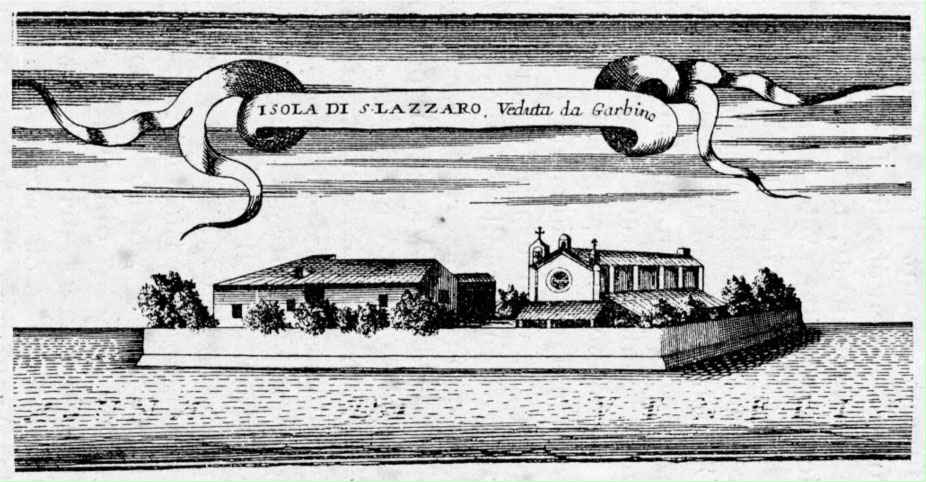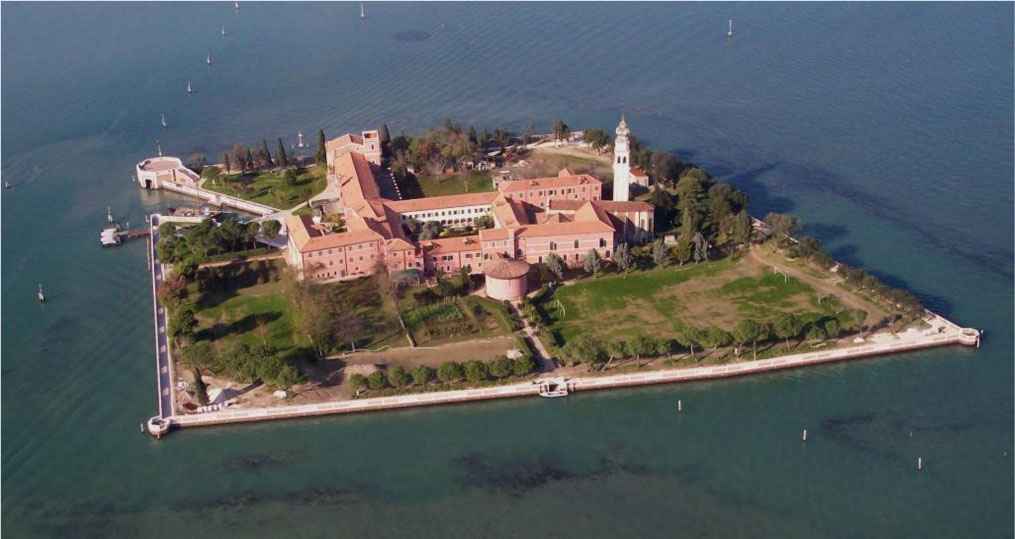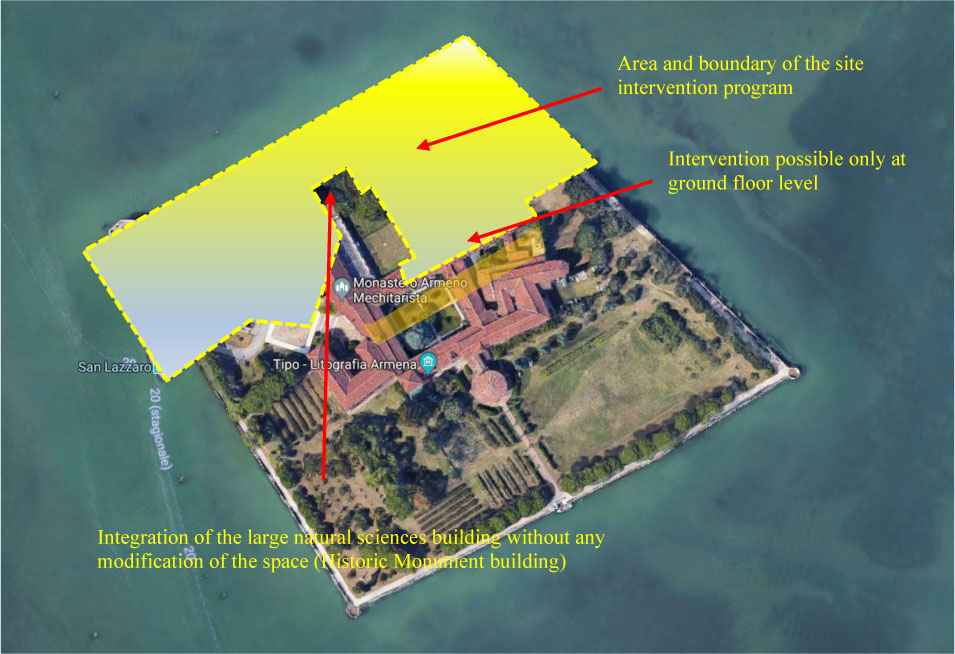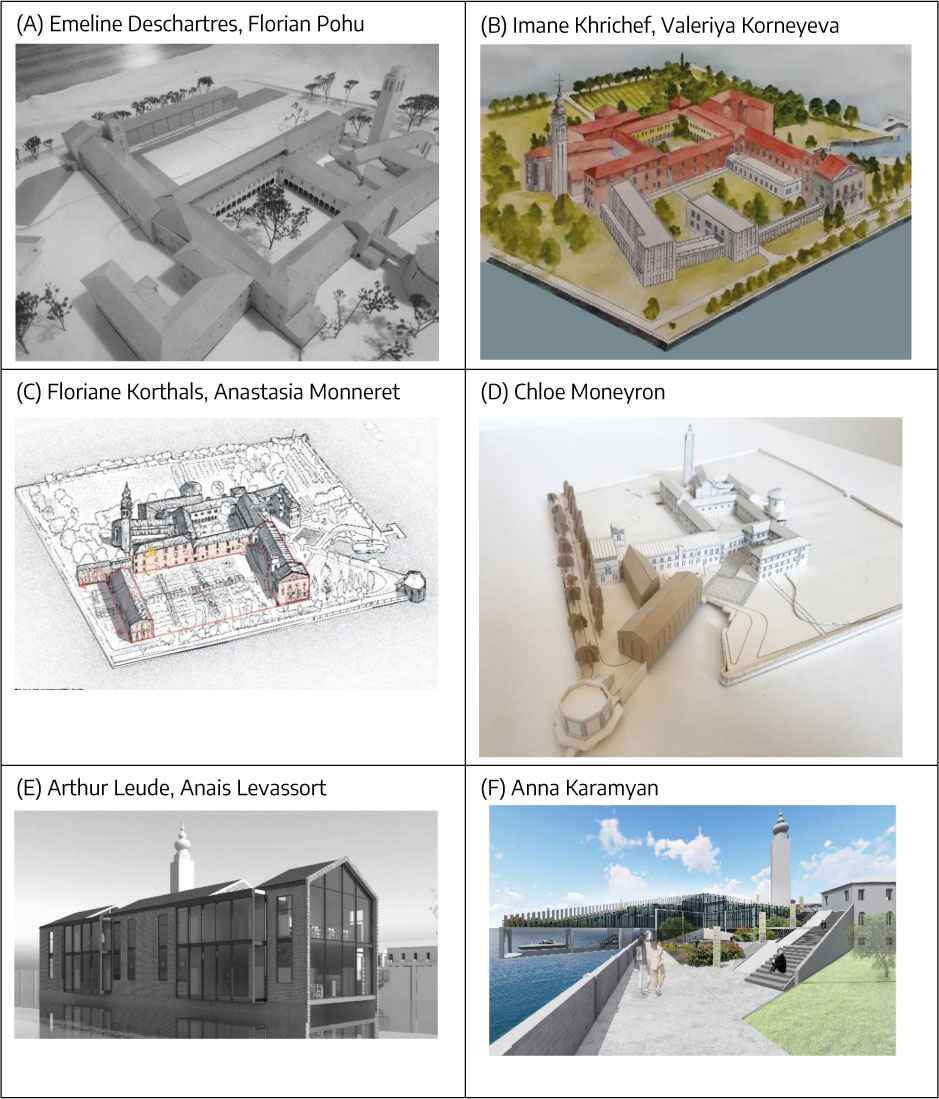Email: arevsam@gmail.com
Revised 29 January 2022
Accepted 7 December 2022
Available Online 10 January 2023
- DOI
- https://doi.org/10.55060/s.atssh.221230.025
- Keywords
- Armenian community
Mekhitarist Congregation
Regeneration
Revalorization - Abstract
The extension and historical evolution of the Mekhitarist Congregation monastery complex on Saint Lazarus Island in Venice is covered in this article. Buildings' architecture and the unique aspects of their morphology are examined. The article argues that revaluing the monastic complex is necessary in order to address the local issues at hand. It will enable the complex's outstanding historical and cultural significance to be preserved while also allowing it to satisfy the Congregation's contemporary needs. The analysis of the concepts developed within the framework of the master's international educational program “IACOBUS plus” enabled the authors to identify the main approaches and challenges of the monastic complex's revalorization. They are classified into six main groups, which are graphically displayed in a table.
- Copyright
- © 2022 The Authors. Published by Athena International Publishing B.V.
- Open Access
- This is an open access article distributed under the CC BY-NC 4.0 license (https://creativecommons.org/licenses/by-nc/4.0/).
1. INTRODUCTION
Earliest origins of Armenian communities in Western Europe date back to the 6th century. However, the greatest number of Armenians moved there during the 11th and 14th centuries, during the Crusades and the Cilician period, and once more in the 17th century, when Armenian traders from Iran opened trading posts in numerous cities throughout Western Europe.
In the 6th century, Armenian soldiers from the Byzantine Empire landed in Italy. Under the command of Emperor Constance, Armenian generals and contingents battled in Sicily in the 7th century. After Cilicia fell in 1375, a sizable influx of Armenian refugees traveled from Cyprus to Italy. Around 30,000 Armenians were residing in Italy during the first quarter of the 15th century, according to historian Ghevond Alishan [1].
Their principal location was Venice, where an avenue and a bridge were dedicated to the Armenians. In a number of Italian cities, “Armenian houses” (casa degli Armeni), hospices where Armenian craftsmen and merchants gathered, were built.
The Armenian homeland was split between the Ottoman Empire and Persia for many years, and there were sizable Armenian communities in Cilicia and later in Constantinople. As a result, the Classical Armenian language developed into two important modern dialects, Western Armenian and Eastern Armenian. As Latin did in the Catholic Church, classical Armenian was still used in the liturgy. The vast majority of Armenian books were published in Classical Armenian up to the 19th century [2].
The Ottoman conquest of its own colonies in the East and the fall of Constantinople hurt the Venetian Republic, but Venice kept its place as the most significant commerce hub of the Western world and one of the most populated cities. It was the main exporter of Western technology and culture to the East and was home to the greatest Armenian colony in the West.
The first publications printed in Armenian can be attributed to the Armenians of Venice [3]. Hakob Meghapart published a Prayer Book and a Ceremonial Calendar in two volumes in 1512.
While ties between the two faiths alternated between enmity and collaboration, the Catholic Church converted many Apostolic Armenians. The Mekhitarists, a group of Armenian Catholics, began making significant contributions to printing and scholarly work in Armenia around 1700. Christianity was crucial to the growth of Armenian book production [4]. Mekhitar of Sebastia established the Mekhitarist Congregation in 1701 in Constantinople. It is a religious, educational, scientific, and cultural institution. He and his ideologists were forced to flee the Ottoman Empire's capital due to difficult political and religious circumstances. They finally settled on San Lazzaro Island near Venice in 1717 after extensive travelling (Fig. 1). The same year, the Senate of Venice agreed to grant Mekhitarists the right to permanent residence on San Lazzaro Island. They migrated to San Lazzaro Island, which is still owned by them today, after Mekhitar of Sebastia was ordained Abbot and assumed leadership of the order.
On 17 August 1810, by Napoleon Bonaparte’s manifesto, San Lazzaro's Armenian congregation was established as a scientific institution with the title of “Armenian Academy”.

San Lazzaro Island, 1696 (from the Mekhitarists’ archive).
2. DEVELOPMENT OF SAN LAZZARO ISLAND AND THE MEKHITARIST CONGREGATION
Beginning in the 9th century, the island of San Lazzaro has a documented history. The Benedictine Monastery of St. Ilario of Fusina's abbot received the island in 810 from the Republic of Venice. In 1182, a local lord named Leone Paolini moved the modest San Travaso hospital on the island. Thus, a leper colony hospital for those with leprosy, which was chosen for that purpose due to its relative isolation from the main islands composing the city of Venice, was created on the island. An inscription in Gothic script confirms the church of San Lazzaro's founding year of 1348.
When Mekhitar and his associates were given the island in perpetuity in 1717 and moved there, they immediately began to restore the structures, starting with the most critical roof and window repairs. Five years after the reconstruction of the church ended. Mekhitar began working on his plan to build a new monastery the next year, and it was completed in 1740 with a dining room and library. Mekhitar Abbot passed away in 1749 and was buried in front of San Lazzaro Island's large shrine [5].
Construction on a modest printing pavilion at the far northwest end began in 1789 under the direction of Abbot Stephanos Melkonian, who was Mekhitar's first successor. Following a visit from Austrian Emperor Franz II, who gave permission to fill in the region to the immediate north, the Congregation profited from the island's first big expansion in 1815, which nearly doubled the area from 7,900 to 13,700 m2. Between 1823–1825, the newly available space enabled the construction of the wing of the new printing house, which included the sala dell'Accademia above, roomy cells, and eventually the Chapter House. Work on the border wall surrounding the area of the island that was filled in 1815 began a few years later, in 1836.

San Lazzaro Island, 1947 (photo from the Mekhitarists’ archive).
A round room filled with murals and plasterwork by Giuseppe Cherubini was later added to the library in 1866, but it was destroyed in a fire in 1975.
The sala dell'Accademia at the end of the north wing was converted into a natural history museum between 1869–1875. The nearby astronomical observatory was also constructed at the same period.
The church's apse was expanded in 1899, and some neo-Gothic features were added. By adjusting the octagonal terrace that had been built there a few years earlier and smoothing the shoreline, the boathouse was moved to the far end (western corner) of the island in 1912 after the channel of the boathouse was filled in. The island now spans 16,970 m2 as a result of this recent development.
The ultimate enlargement to around three hectares with significant landfills on the island's southwest and southeast edges was authorized immediately following the war, starting in 1947 (Fig. 2).
The erection of a dedicated area for the safety of the historic manuscripts kept at San Lazzaro was paid for in 1967 by the donor Boghos Ispenian, who foresaw the possibility of fire breaking out (as it did in 1975). The benefactor's son, the architect Andon Ispenian, created a cylindrical tower.
3. REGENERATION CHALLENGES AND OPPORTUNITIES AT THE MONASTERY
As of right now, the island is home to a church with a neo-Gothic interior, a tall onion-shaped campanile, residential buildings, a library, a museum, a painting gallery, a manuscript repository, a printing house, various teaching and research facilities, gardens, a bronze statue of Mekhitar created by Antonio Baggio in 1962, an Armenian Genocide memorial built in the 1960s, a 14th-century khachkar, and more (Fig. 3).
The Mekhitarist Congregation, having a religious mission, remains deeply educational and cultural also. Through his enlightening vocation, he has for centuries federated and preserved richly cultivated collections.
By establishing the Armenian printing press outside of Armenia, the Mekhitarists carry on their job. They are now humble and hardworking. The Witness is distinguished by its diversity and its extensive collection, which contains more than 200,000 books as well as valuable manuscripts and papyrus books from all throughout the world. The Mekhitarists consolidated their island out of concern for the preservation and spread of this culture.

Aerial view of San Lazzaro Island.
This is supported by the fact that the historical legacy and architectural complex on this lovely island have been tripled in size while also integrating Armenian identity with European acoustics. It is possible to give a succinct overview of the Brotherhood's history while upholding Armenian identity and showing utmost respect for European ideals, culture, and science. This small island has been full of cutting-edge humanitarian concepts at the European and worldwide levels since it was founded with the goal of serving Armenology and advancing Armenian culture and science. The more than 300-year history of the Mekhitarist Congregation and San Lazar Island near Venice can serve as a more than encouraging case study for European unity.
The Mekhitarist collection continues to grow through gifts and purchases made all across the world each year. The monks are finding it more and harder to present the various collections in a logical order, and the library's shortage of room is particularly concerning. Furthermore, the introduction of new technology has irrevocably replaced the “mechanical manufacturing” of books, elevating the old printing presses to the status of museum artifacts. The monks work to conserve these devices as a testament to the history and philosophy of the Mekhitarists.
The Mekhitarists have continuously added buildings and extended land on San Lazzaro Island with care and finesse for just over three centuries (Fig. 4). For the island and monastic community, the start of the 21st century heralds a new period of development that must be integrated into the ongoing activity of Mekhitar while considering the new environmental conditions in light of new requirements.
As a result, there are several issues that arise today, such as the necessity to build a new library and to reconsider how publishing tools and machinery should be displayed by reorganizing and expanding the current museum area. The extremely destructive record floods in November 2019 associated with the “Acqua Alta” phenomenon serve as a reminder that any undertakings involving the Venice lagoon must be handled with caution and due consideration.
The site's evolution through time and its history have molded a precisely defined organization. The monastery's existence spread out from the modest church in the middle of the undeveloped island, with constructions facing Venice in the northwest and an expansion of the gardens on the south side, covering areas ranging from 7,000 to 30,000 m2. Gardens and minor agricultural operations have always been restricted to the southern portion of the island, where there is also a cemetery for Mekhitarist monks [6]. The monks are particularly committed to the history of the island's development, to the ancient gardens, and to their production of “Vardanush” roses, thus the inscription of the new project will perpetuate this permanence. Consequently, the initiative has the best chance of success in the island's northwest (Fig. 5).

San Lazzaro Island development timeline by Arthur L'Heudé and Anais Levassort (ENSACF).

The site intervention and its limits.
The revised proposal contains two interventions: one involves rearranging and adapting the North wing's ground floor area, which is currently home to the publishing museum, and the other involves building new spaces that must relate to the existing location.
The IACOBUS+ Master program assigned the Mekhitarist monastery regeneration mission. For architecture students in their last year of study, the project IACOBUS+ Culture, Heritage and Integration provides an academic setting in a global university setting. The IACOBUS program, a collaboration agreement that involved about 1,000 students, teachers, and experts from the University of A Coruna, the ENSA of Clermont-Ferrand, and the OTH of Regensburg since 1995, served as a foundation for this one. The plan revolves around a number of initiatives to raise awareness of, and intervene in, heritage places that are in danger of disappearing due to a lack of legislative safeguards, abandonment, ruin, or urban pressure. It focuses on finding new uses for structures and reviving their surroundings as part of an architecture and research exercise with a significant influence on the local people. It should be noted that the research was conducted on the basis of historical-architectural principles, which can become an ideal opportunity to not only reveal the perspective of the development of the island's architecture but to also monitor the chronological overview of their creation and formation. [7].
During one semester of 2020, the initiative involved more than 60 students (Master 1 and Master 2) from A Coruna (Spain), Regensburg (Germany), Clermont-Ferrand (France) and Yerevan (Armenia). Finally, they displayed highly intriguing and even very audacious initiatives online.

Armenian Mekhitarist Congregation monastic complex regeneration concepts by the IACOBUS+ Master program students in 2020.
4. CONCLUSION
After carefully examining the results, it can be said that over the ages, historically significant and important structures and complexes have undergone a steady change. The growth of the architectural complex at the monastery of the Mekhitarist Congregation is a superb illustration of it. It still has to be changed in order to satisfy contemporary demands. Therefore, working with a magnificent legacy is challenging and responsible, but we shouldn't shy away from new interventions because they will only give the heritage new life and vigor.
The analysis of the master's works that were put into practice (including research on 250 A3 pages and projects) revealed that their primary ideas may be divided into five divisions (Table 1):
The new addition volumes organize a close inner courtyard, which historically is typical of the monastery (Table 1A);
Various forms of courtyard restructuring (new structures linking to existing structures from various angles) (Table 1B, Table 1C);
The port's reformation has received the most of attention (Table 1D);
Fresh chances to increase the size of the island by submerging the buildings in the water (Table 1E);
Different options (Table 1F).
AUTHORS' CONTRIBUTION
Emma Harutyunyan – Collected and evaluated the historical process of the expansion and development of the St. Lazarus Island complex of the Mkhitaryan monastery, the architecture of the buildings, and the unique features of their morphology. Contributed to the creation of finished conceptual projects.
Arev Samuelyan – Contributed to the creation of finished conceptual projects of the Mekhitarist Congregation complex in St. Lazarus. Analyzed all conceptual projects put forward and divided them into six major categories, which are graphically displayed in a table.
REFERENCES
Cite This Article

TY - CONF AU - Emma Harutyunyan AU - Arev Samuelyan PY - 2023 DA - 2023/01/10 TI - Regeneration Issues of the Armenian Mekhitarist Congregation Monastic Complex on San Lazzaro Island BT - Proceedings of the 4th International Conference on Architecture: Heritage, Traditions and Innovations (AHTI 2022) PB - Athena Publishing SP - 193 EP - 199 SN - 2949-8937 UR - https://doi.org/10.55060/s.atssh.221230.025 DO - https://doi.org/10.55060/s.atssh.221230.025 ID - Harutyunyan2023 ER -









